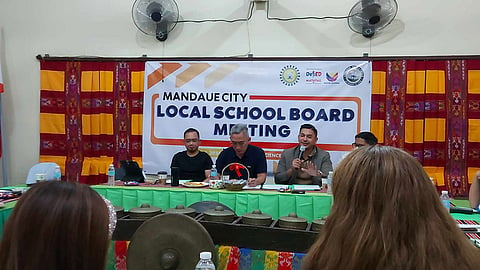

MANDAUE City Government’s plan to adopt blended learning instead of suspending face-to-face classes amid the scorching heat caused by the ongoing El Niño phenomenon has drawn mixed reactions from the public.
During a local school board meeting held at Mandaue Science High School in Barangay Ibabao-Estancia on Wednesday, April 3, 2024, Bianito Dagatan, the schools division superintendent of the Department of Education (DepEd) School Division Office of Mandaue City, proposed that measures should be implemented to ensure that students can effectively learn, as most students tend to have less knowledge retention without the guidance of their teachers.
Blended learning, as defined by DepEd, offers an innovative approach to education, enabling students to access learning materials both online and offline.
This method caters to different learning styles and preferences, accommodating those who thrive in a traditional classroom setting, as well as those who prefer computer-based training.
With blended learning, students can benefit from a personalized and flexible learning experience that is both engaging and effective.
Poor concentration
Majority of students from Mandaue City who were interviewed by SunStar Cebu on Wednesday expressed their agreement with blended learning.
But many of them said that having full modular classes would help them concentrate better.
They feel that staying in classrooms, especially during the extremely humid weather, is not conducive to learning.
John Ashley Escalderon, a 13-year-old Grade 6 student of Canduman Elementary School, admitted that he often feels sick and suffers from headaches, especially when attending classes in the afternoon when the heat of the sun is at its peak. This, he said, affects his concentration in class and makes it difficult for him to learn.
Josh Benedict Anota, a 16-year-old Grade 10 student of Mandaue City Comprehensive National High School (MCCNHS), said their classroom lacks ventilation, making their learning area more humid. This often distracts him while learning in class.
Escalderon and Anota suggested that transitioning to blended learning could provide them with more opportunities to relax and find ways to keep themselves cool while studying, which would enable them to concentrate better on their studies.
As of Wednesday, Mandaue has yet to decide on whether to switch to blended learning or full modular classes.
In the meantime, the two students said they had to bring sufficient water and portable fans with them to cope with the heat in class.
Interesting activities
Analiza Amit, a 57-year-old Grade 8 adviser at the MCCNHS, frequently incorporates engaging activities into her lessons to grab her students' attention amid the extreme heat.
Letessie Diano, 50, who teaches students in grades 11 and 12, has noticed that her students are more motivated to focus on face-to-face classes.
As an educator, Diano has found a creative way to integrate real-life scenarios and situations related to the current extreme heat the country is experiencing into her lessons.
Meanwhile, Joje Bantilao, a 47-year-old Grade 6 adviser at Don Calixto Yongco Elementary School in Barangay Tawason, is in favor of blended or full face-to-face classes, saying their classrooms are well-ventilated with plenty of trees. But they face issues related to lack of adequate water supply.
Amit, Diano, and Bantilao all agreed that face-to-face classes are beneficial for tracking their student's progress, particularly for those who are struggling.
They emphasized that at times, parents may be unable to supervise their children's learning while studying at home due to other household responsibilities.
Not a new situation
Nicolle Gallardo, a parent of a Grade 3 student, said extreme heat is not new to students, especially during the summer months.
She believes that dividing classes would only encourage, particularly elementary students, to play instead of studying their lessons after class.
Sheryl Mepranum said her Grade 6 child's school has enough electric fans to beat the heat, so she is fine with her child taking blended learning.
But it is a different situation for her Grade 8 student who attends school in Jagobiao and has afternoon classes.
Mepranum said she agreed to have her Grade 8 student under blended learning to ease her inconvenience walking to school amid the scorching heat.
Gallardo said that she often gives her child extra money to buy beverages and allows her to bring snacks and water to avoid dehydration.
Mepranum also reminded her children to drink enough water.
At the meeting, Mandaue Mayor Jonas Cortes, who is also the school board chair, announced that he plans to release an executive order (EO) that will formalize a decision based on the recommendations of all involved stakeholders.
Representatives from school divisions, Parent Teachers Associations (PTAs), and other school personnel have been given until 3 p.m. Wednesday to discuss and present their suggestions.
Cortes said these suggestions will serve as the basis for his EO. (HIC)